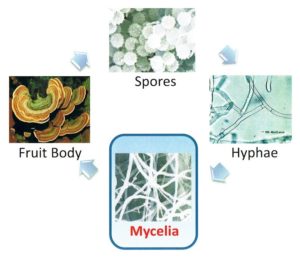Mycelia Extract

The Mushroom Life Cycle
The secret of inForce is the mycelia extract polysaccharide peptide & polysaccharide krestin of the Coriolus Versicolor Mushroom.
Saccharides are one of the most important biomolecules in the world. Also known as carbohydrates, they are responsible for various roles in all living things, most notably in controlling the energy in cells as well as providing structural integrity. In addition, saccharides provide a role in the immune system, development and fertilization. These molecules are the most abundant organic matter on the planet. They provide the basic backbone of energy storage, fuel cellular function and render the metabolic processes stable. Also, saccharides form the structural framework for ribonucleic acid (RNA) and deoxoribonucleic acid (DNA) with the basic sugars ribose and deoxyribose. Bacterial and plant cell walls are comprised of the biomolecule, resulting in its overwhelming abundance. Lastly, these carbohydrates play the key role in controlling the interactions of cells themselves as well as collections of cells. This is caused by the saccharide link to proteins and lipids.
Saccharides are comprised of two basic compounds: aldehydes and ketones, both of which contain a carbonyl group composed of double-bonded carbon and oxygen atoms. Aldehydes have the addition of a hydrogen atom, while ketones bond with two additional carbon atoms. However, there are additional forms of saccharides which feature covalent bonds in which electrons are shared by oxygen and hydrogen. These are known as hydroxyl groups.
When a compound for this biomolecule is collected, it is known as a monosaccharide. The major examples of these are glucose, galactose and fructose. Glucose is also known as blood sugar and is the major source of energy for a cell. Galactose and fructose are also major sugars. Galactose is found most readily in milk and dairy products, while fructose is found in most vegetables and fruit.
Monosaccharides merge together in linked groups known as polysaccharides. Polysaccharides are essentially carbohydrate structures formed from repeated units bonded chemically. This form of link is known as a cosidic bond. Usually, polysaccharides form into linear compounds; however, various branching can occur, changing the shape. Polysaccharides are known as macromolecules and feature a number of different properties such as a repositioning of atoms and possible insolubility in water.
Glycobiology
Glycobiology studies the biology, chemical synthesis and structure of sugars and saccharides as singular molecules and in combination with other molecules. The vast field combines traditional sciences and involves various medical biochemical and biotechnological fields. The subcategory research of glycomics analyzes sugars and combined molecular structures with respect to genetics, pathology and physiology. With advanced technology, researchers discovered that sugar chains, or glycans, play a much more complex role than merely acting as an energy resource for all living organisms.
Though the word “glycobiology” first appeared in the Oxford English dictionary in 1988, the innovative field produced preliminary discoveries in the late 1800s. Combining organic chemistry and cellular biology, researchers uncovered the dependent relationship between sugars and proteins in all living organisms. Glycan-protein relationships were instrumental in the creation of penicillin.
As of 2010, scientists had yet to comprehend and unlock the entire glycan language. Glycobiologists have discovered that carbohydrate coding increases in complexity when combined with various other molecules. The act of sugar and protein integration, or protein glycosylation, appears vital for proper functioning of numerous cellular activities within the body. Studies derived from glycobiology suggest that glycans affect and regulate every aspect of cellular existence.
Cells require sugars not only for energy but also for recognition and interaction with other cells. Basic cellular structural integrity relies heavily on complex protein-glycan combinations. The presence of carbohydrates controls embryonic development triggers growth factors and regulates hormones. Blood clot-ting, cellular adhesion properties and receptor binding also require protein-glycan molecules. Breakthroughs in glycobiology show promise in furthering the understanding of pathogenic organisms while enhancing the development of revolutionary medications.
Polysaccharides (glyconutrients) are:
- Soothing
- Produce healthy youthful skin cells
- Help keep us slim and trim
- Help detoxify our bodies
- Improve and educate our immune system
- Increase our brain power.
PRIMAL FOODS
Primal foods that contain most or all eight essential saccharides include rice bran, barley bran, oat bran, mushrooms, yeast cell walls, aloe vera and gum sugars. Most of these sugars are not sweet but bitter and thus have a low glycemic index. While scientists believe that people in good health can produce these sugars from glucose and galactose, it’s a very taxing process. In fact, it’s extremely difficult for diabetics and others who are sick or stressed to make the conversion. Basically, the more essential saccharides that you add to your diet, the fewer number of steps, and the less enzymes and energy your body has to expend, to manufacture them. Other glyconutrient rich primal foods include garlic, onions, leeks, carrots, fenugreek, psyllium seeds, radishes, pears, coconut meat, tomatoes, beans, kelp and figs.
 GET YOUR FREE BOTTLE OF INFORCE
GET YOUR FREE BOTTLE OF INFORCE